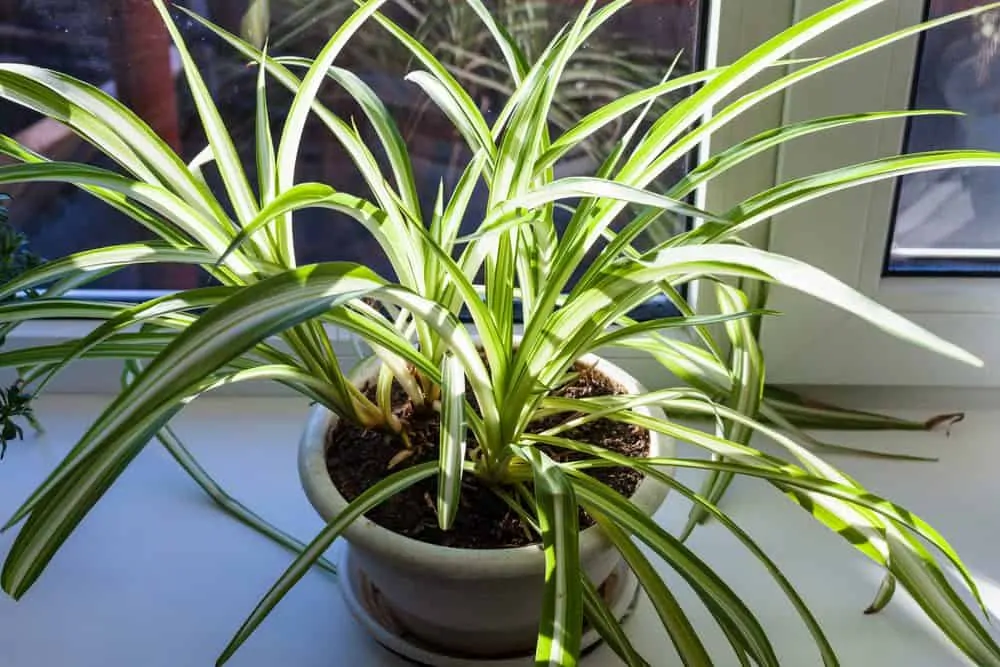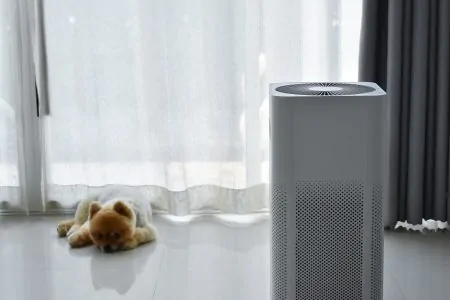Since houses have become more energy-efficient, they also trap more pollutants due to poor ventilation. Your indoor air can actually be up to five times more polluted than outdoor air.
There are many ways you can improve your indoor air quality. One natural way involves houseplants. Plus, they can do so without power or fuel.
Let’s check out the 15 best air purifying plants. This is based on hours of research into expert advice and scientific studies, so you can be sure these plants will help.
Key Takeaways
- Indoor air can be more polluted than outdoor air due to poor ventilation.
- Houseplants can help improve indoor air quality by absorbing harmful toxins.
- NASA research found that certain plants are effective at removing pollutants like benzene, formaldehyde, and ammonia.
- Some of the best air-purifying plants include peace lily, bamboo palm, and spider plant.
Do Plants Really Clean the Air?

NASA has done extensive research for decades regarding cleaning the air in space stations. They’ve found that certain plants absorb carbon dioxide, a common pollutant produced by humans.
Plants are also effective at absorbing certain other toxins (1).
Some harmful toxins plants can remove include:
- Benzene.
- Formaldehyde.
- Trichloroethylene.
- Ammonia.
Experts say that plants make effective natural air purifiers, especially big, leafy plants. However, not everyone is as convinced of the effectiveness of houseplants.
It’s important to remember that NASA did its studies in closed space stations. As such, the effect you experience in your home will be different.
What’s more, newer studies done in 2009 seemed to prove this fact. They showed that the effectiveness of air cleaning plants changed significantly when moved from a controlled space to an open room.
However, researchers say that simply airing out your home will have a greater effect on the air quality than a plant (2).
Benefits of Indoor Plants

Despite inconclusive research regarding the effectiveness of air-cleaning plants, there are still plenty of benefits to gain from indoor plants.
Below, we’ve listed some of the top benefits houseplants bring to your home:
- Fresh oxygen: As we breathe in oxygen, we produce carbon dioxide that is released back into the air. Plants will turn carbon dioxide back into oxygen through photosynthesis. However, only some plants (like orchids and succulents) will do this at night (3).
- Creates cleaner air: NASA found that plant leaves and roots remove toxic vapors. It further showed that low levels of formaldehyde and carbon monoxide were removed by plant leaves alone (4).
- Increases humidity: This may or may not be beneficial depending on your climate. However, plants evaporate small amounts of moisture through their leaves via transpiration. This leads to slightly higher humidity levels indoors where the houseplants are located. A study conducted in Norway showed that indoor plants decreased dry skin, sore throats, coughs, and colds (5).
- Improves mood: Indoor plants work as natural antidepressants to reduce stress and anxiety and improve your mood and productivity (6).
Best Air Cleaning Plants for the Home

There’s no doubt that having a few green plants in your home is beneficial. However, if you want to make a difference, you’ll need the best air cleaning plants.
After thorough research, we found the most effective houseplants and how to care for them. Here’s a quick list of the best plants and which harmful toxins they remove from the air:
| Plant | Benzene | Formaldehyde | Trichloroethylene | Xylene and toluene | Ammonia | Edible? |
|---|---|---|---|---|---|---|
| Peace lily | Yes | Yes | Yes | Yes | Yes | No |
| Florist’s chrysanthemum | Yes | Yes | Yes | Yes | Yes | No |
| Bamboo palm | Yes | Yes | Yes | Yes | No | Yes |
| English Ivy | Yes | Yes | Yes | Yes | No | No |
| Variegated snake plant | Yes | Yes | Yes | Yes | No | No |
| Red-edged dracaena | Yes | Yes | Yes | Yes | No | No |
| Barberton daisy | Yes | Yes | Yes | No | No | Yes |
| Green spider plant | No | Yes | No | Yes | No | Yes |
| Cornstalk dracaena | Yes | Yes | Yes | No | No | No |
| Aloe vera | Yes | Yes | No | No | No | No |
| Weeping fig | No | Yes | No | Yes | No | No |
| Chinese evergreen | Yes | Yes | No | No | No | No |
| Heartleaf philodendron | No | Yes | No | No | No | No |
| Selloum philodendron | No | Yes | No | No | No | No |
| Elephant ear philodendron | No | Yes | No | No | No | No |
1. Peace Lily
- Botanical Name: Spathiphyllum.
- Sunlight Needs: Moderate to bright indirect light.
- Water Needs: Water occasionally.
Peace lilies are some of the most beautiful flowers to grow indoors. This plant is native to the forest floor, so if you want success in keeping these indoors, you’ll have to mimic those conditions.
Keeping them in bright, indirect light with moist soil is the key to getting those beautiful flowers to grow. Peace lilies can remove the following toxins:
- Benzene.
- Formaldehyde.
- Carbon monoxide.
- Trichloroethylene.
- Xylene and toluene.
- Ammonia.
Poisonous
2. Florist’s Chrysanthemum
- Botanical Name: Chrysanthemum morifolium.
- Sunlight Needs: Full sun.
- Water Needs: Medium watering.
Florist’s chrysanthemums are beautiful perennials with compact flowers. The plant is native to China, where it’s commonly used in anxiety-treating medicine. You should feed the plant several times during the growing season to create the best bloom.
Florist’s chrysanthemums can remove a large number of toxins from the air. These include:
- Benzene.
- Formaldehyde.
- Trichloroethylene.
- Xylene and toluene.
- Ammonia.
Toxic Warning
3. Bamboo Palm
- Botanical Name: Chamaedorea seifrizii.
- Sunlight Needs: Partial sun exposure, bright indirect light.
- Water Needs: Water occasionally.
Bamboo palms bring lots of color and warmth to any room. This tropical-looking plant is excellent for a bohemian interior.
Thanks to the luscious leaves, the bamboo palm will remove several toxins, which include:
- Formaldehyde.
- Benzene.
- Trichloroethylene.
- Xylene and toluene.
Bamboo palms are non-toxic and perfectly safe to plant in a family home with pets.
4. English Ivy
- Botanical Name: Hedera helix.
- Sunlight Needs: Six to eight hours of indirect light.
- Water Needs: 1 inch of water per week.
The English ivy is a non-native perennial vine commonly used in landscaping and ground cover. The plant produces fruits that birds feed on. This is also how the plant reproduces when the birds disperse the seeds.
You’ll often find this plant growing on buildings and structures. However, you should keep it from growing on other trees as the vines will suffocate the branches (9).
English ivies are known to remove the following toxins:
- Benzene.
- Formaldehyde.
- Trichloroethylene.
- Xylene and toluene.
Keep In Mind
5. Variegated Snake Plant
- Botanical Name: Sansevieria trifasciata.
- Sunlight Needs: Part shade.
- Water Needs: Water regularly.
Variegated snake plant, also known as mother-in-law’s tongue, is an easy-to-grow houseplant. It tolerates different environments but prefers warm and sunny locations.
NASA found that variegated snake plants will remove the following toxins:
- Formaldehyde.
- Benzene.
- Trichloroethylene.
- Xylene and toluene.
Poisonous
6. Red-Edged Dracaena
- Botanical Name: Dracaena marginata.
- Sunlight Needs: Bright indirect light.
- Water Needs: Minimal water.
Red-edged dracaena, also known as dragon tree, is a unique-looking houseplant. The narrow, slender stems lead to stiff, sword-like green and red leaves. When grown outdoors, it will bloom with tiny, fragrant white flowers and produce yellow-orange berries.
Red-edged dracaena plants will remove some toxins, such as:
- Formaldehyde.
- Benzene.
- Trichloroethylene.
- Xylene and toluene.
Toxic To Pets
7. Barberton Daisy
- Botanical Name: Gerbera jamesonii.
- Sunlight Needs: Full sun.
- Water Needs: Moderate watering.
Barberton daisies are often seen in florist shops thanks to the large flowers in different colors. This plant can be tricky to grow indoors since it requires full sun exposure to bloom. The leaves are very unique-looking, covered in white, silky hairs.
This plant effectively removes the following toxins from the air:
- Benzene.
- Formaldehyde.
- Trichloroethylene.
Barberton daisies are non-toxic plants; they don’t pose any risk to pets or children.
8. Green Spider Plant
- Botanical Name: Chlorophytum elatum.
- Sunlight Needs: Bright, indirect light.
- Water Needs: Water regularly.
Green spider plants are generally easy to grow and are the perfect addition to indoor decor with long, thin leaves. There are many varieties of spider plants, but the green spider plant has unique cream and green colored leaves.
In NASA’s studies, it concluded that the green spider plant was capable of removing:
- Formaldehyde.
- Xylene.
This plant is also an excellent addition to a family home with furry friends since it’s non-toxic to pets.
9. Cornstalk Dracaena
- Botanical Name: Dracaena fragrans.
- Sunlight Needs: Filtered sun.
- Water Needs: Minimal water.
Cornstalk dracaena plants get their name from their corn-like leaves. Most famous for its palm-look and grand size — reaching 45 feet when mature — this plant is also capable of removing toxins. NASA found that the cornstalk dracaena will remove toxins such as:
- Benzene.
- Formaldehyde.
- Trichloroethylene.
Toxic Warning
10. Aloe Vera
- Botanical Name: Aloe vera.
- Sunlight Needs: Bright light.
- Water Needs: Water regularly.
Aloe vera is a succulent used for thousands of years as a medicinal plant. You’re likely familiar with aloe vera moisturizers and ointments.
Succulents require dry conditions. Although they should be watered infrequently, when watered, the soil should be well soaked. You can plant aloe vera in cactus soil for the best results.
Aloe vera is commonly known to remove these toxins from the air:
- Benzene.
- Formaldehyde.
Toxic To Certain Animals
11. Weeping Fig
- Botanical Name: Ficus Benjamina.
- Sunlight Needs: Bright indirect light.
- Water Needs: Water regularly.
Weeping fig plants, also known as ficus trees, grow large and broad dark green leaves. It’s native to tropical and subtropical environments where it grows as large trees. However, weeping figs are also trendy indoor plants, often used in offices.
A unique trait of weeping figs is a braided stem that’s easily done as the plant grows. It’s very efficient at removing toxins such as:
- Formaldehyde.
- Xylene and toluene.
Toxic
12. Chinese Evergreen
- Botanical Name: Aglaonema modestum.
- Sunlight Needs: Partial exposure.
- Water Needs: Water moderately.
Chinese evergreen is a dark-green, leafy plant native to tropical environments, such as swamps and rainforests. This plant does prefer warmer and more humid environments, so you should keep it at temperatures above 55 degrees Fahrenheit.
Chinese evergreen is known to remove the following:
- Benzene.
- Formaldehyde.
Poisonous Crystals
13. Heartleaf Philodendron
- Botanical Name: Philodendron cordatum.
- Sunlight Needs: Indirect light.
- Water Needs: Moderately.
Heartleaf philodendron is a small houseplant with pretty heart-shaped leaves. It’s a climbing or trailing plant, often used in hanging pots.
Philodendron cordatum is known to remove formaldehyde from the air.
Toxic
14. Selloum Philodendron
- Botanical Name: Philodendron bipinnatifidum.
- Sunlight Needs: Part shade.
- Water Needs: Water regularly.
Also known as the tree philodendron, selloum philodendron is a split-leaf plant with a semi-woody shrub.
When in bloom, this plant will produce small apetalous white flowers. However, this is rarely seen on indoor plants. Similarly to the heartleaf philodendron, this plant will remove formaldehyde from the air.
Toxic
15. Elephant Ear Philodendron
- Botanical Name: Philodendron domesticum.
- Sunlight Needs: Low-light.
- Water Needs: Water moderately.
Elephant ear philodendrons are climbing variegated plants that can grow on buildings and trees without causing harm. They have giant elephant ear-like green leaves with cream patches dispersed throughout the leaf.
Lots of pot space is the key to a large and beautiful domesticum. It requires lots of room for its roots to grow tall and fast. Elephant ear philodendron will remove formaldehyde from the air.
Toxic
Air Cleaning FAQs

Other Ways to Clean Indoor Air

Apart from houseplants, there are many other ways to clean indoor air.
Here are a few things you can try:
- Increase ventilation: Working a fan, AC unit, or even opening a few windows can help to bring some fresh air into your home.
- Install an air purifier: Houseplants can’t do all the work, so investing in an air purifier is recommended. These devices will pull air through several filters, cleaning it and then emitting the clean air back into the room. Air purifiers effectively remove what plants can’t, such as dust, mites, mold spores, and other airborne pollutants.
- Clean regularly: Removing dust, mites, dirt, and other pollutants regularly can improve the environment.
- Use the right vacuum: Vacuums effectively remove allergens and dust. However, the wrong vacuum can do more harm. A vacuum with a lousy filter will release small amounts of fine dust back into the air. So choose HEPA-filtered vacuums that trap even the tiniest particles.
- Avoid harsh chemicals: Volatile Organic Compounds (VOCs) are found in many common household cleaners, as well as other chemicals. Try to steer clear of these whenever possible. Instead, use natural cleaners such as vinegar and baking soda, which work well for most cleaning jobs.




























